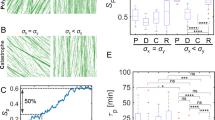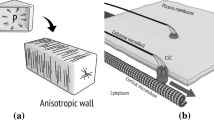Abstract
In turgid multicellular organs, it is convenient to differentiate between the two kinds of tensile forces acting in cell walls as a result of turgor pressure. The primary forces occur both in situ and in cells isolated from the organ, whereas the secondary forces occur only in situ. The latter are an unavoidable physical consequence of the variation in mechanical parameters of tissues forming layers or strands. The most rigid tissue is under maximal tensile force, whereas the least rigid is under maximal compressive force. These forces cause tissue stresses (that is, certain tissues are under tensile stress, whereas others are under compressive stress in the organ). The primary and secondary forces result in primary and secondary stress in cell walls, respectively. The anisotropy of the primary stress is a function of cell shape. For instance, in cylindric cells the anisotropy expressed as the ratio of longitudinal to transverse stresses is 0.5. The anisotropy of the secondary stress is a function of the compound structure of the organ. For example, in the epidermis of sunflower hypocotyl, the longitudinal secondary stress is much higher than the transverse stress. The primary and secondary stresses are superimposed, and, as a consequence, the stress anisotropy in the outer thick walls of epidermal cells is greater than 1. These outer epidermal walls transmit most of the tissue stress. When the epidermis is peeled but remains turgid, only primary stress remains, but loading of the peel can reestablish the original stress anisotropy. We studied the effect of stress anisotropy changes on the orientation of cortical microtubules (CMTs) in the sunflower hypocotyl epidermis. We showed that changes in stress anisotropy cause the CMT orientation to change in the direction of maximal wall stress. In situ, the relatively high tensile tissue stress in the epidermis causes maximal stress in the longitudinal direction and relatively steep CMT orientation. When the tissue stress is removed from the epidermis by peeling, the CMTs tend to reorient toward the transverse direction, which is the direction of maximal stress in the primary component. On application of external longitudinal stress, to substitute for tissue stress, CMTs tend to reorient in the longitudinal direction. However, a relatively high rate of plastic strain is caused by the stress applied to the peel in an acid medium. This produces a less steep orientation of CMTs. It appears that the change in stress anisotropy orients the CMT in the direction in which the stress is maximal after the change, but there is also some effect of the growth rate on the orientation.
Similar content being viewed by others
Author information
Authors and Affiliations
Additional information
Received 4 January 2000; accepted 10 February, 2000
Rights and permissions
About this article
Cite this article
Hejnowicz, Z., Rusin, A. & Rusin, T. Tensile Tissue Stress Affects the Orientation of Cortical Microtubules in the Epidermis of Sunflower Hypocotyl. J Plant Growth Regul 19, 31–44 (2000). https://doi.org/10.1007/s003440000005
Published:
Issue Date:
DOI: https://doi.org/10.1007/s003440000005




